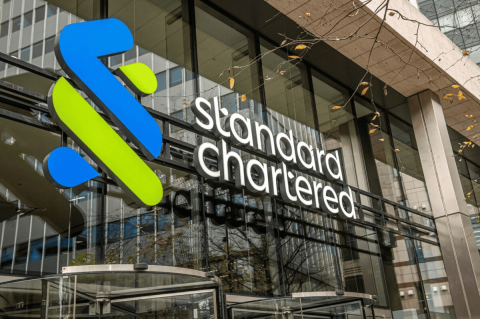Ethereum Price Target Raised to $7,500 by Standard Chartered Essentially Supporting Institutional Cryptocurrency Acceptance
Standard Chartered has dramatically elevated its Ethereum price target to $7,500 for the end of 2025, signifying a seismic shift in institutional confidence and regulatory alignment around the blockchain giant. With corporate treasuries and exchange-traded funds aggressively accumulating ETH, technical network upgrades in progress, and stablecoin markets poised for exponential growth, Ethereum is emerging as the backbone of the future financial system. The bank’s bold multi-year forecasts and bullish fundamental analysis create actionable context for investors tracking the evolving crypto landscape.
Institutional Demand Reshapes Ethereum's Trajectory
A wave of institutional buying activity is reshaping the outlook for Ethereum, the world's second-largest cryptocurrency. According to Standard Chartered’s revised guidance, the bank nearly doubled its previous price target, citing "aggressive institutional accumulation" as the engine powering Ethereum’s ascent. Since early June, Ethereum treasury firms and newly launched spot exchange-traded funds (ETFs) have snapped up nearly 3.8% of all circulating ETH, marking a much swifter accumulation pace than comparable Bitcoin purchases seen during the 2024 U.S. election cycle.
Corporate treasuries are at the forefront of this movement. Over roughly two-and-a-half months, these firms acquired close to 2.3 million ETH, representing 1.9% of total Ethereum supply. Standing out is BitMine Immersion Technologies with its notable holding exceeding 1.2 million ETH, valued at approximately $5.4 billion. Also prominent are SharpLink Gaming with 598,800 ETH and The Ether Machine at 345,400 ETH. This degree of corporate adoption is reshaping institutional perspectives and strategies across the broader digital asset landscape.
The market witnessed record-breaking ETF activity, particularly on August 11, when U.S.-listed Ethereum spot ETFs logged a historical single-day inflow of $1.02 billion. BlackRock’s ETHA unit led the charge, securing $640 million and amassing over 150,000 ETH. Fidelity’s FETH was close behind with $277 million, reflecting swelling demand from traditional finance players.
Regulatory Winds and Network Innovation Fuel Growth
Regulatory clarity is fast emerging as a critical catalyst for Ethereum’s price prospects. The July passage of the GENIUS Act unlocked new certainty around stablecoins—a segment where Ethereum commands a dominant position. More than half of all stablecoins operate on Ethereum’s network, collectively accounting for around 40% of all blockchain transaction fees. With this legal foundation, the stablecoin market is forecast to balloon eightfold to $2 trillion by 2028, according to Standard Chartered, which would further intensify demand for Ethereum both through direct transactional activity and via the decentralized finance (DeFi) ecosystem, in which ETH already secures a 65% share of total value locked.
Driving Ethereum’s utility and resilience is an ambitious roadmap for technical innovation. Vitalik Buterin, Ethereum’s co-founder, intends to scale the network’s Layer 1 throughput by a factor of ten in the coming year. This leap will enable more high-value transactions to be settled efficiently on-chain, while routine or smaller transfers find a home on Layer 2 scaling solutions such as Arbitrum and Base. Such enhancements are poised to reinforce Ethereum’s competitive edge and facilitate the robust adoption needed to sustain its price trajectory.
Price Action and Long-Term Outlook
Trading near $4,700, Ethereum sits just 4% shy of its all-time high of $4,891 from November 2021. Standard Chartered anticipates ETH eclipsing this benchmark by the end of Q3 2025, driven by its increasingly favorable fundamentals and growing advantage versus Bitcoin. The ETH-BTC ratio is expected to climb from 0.036 to 0.05 as Ethereum’s network dynamics and investor profile strengthen. Importantly, this augurs well for Ethereum’s positioning in diversified portfolios and for those seeking exposure beyond the digital gold narrative.
The bank projects a series of ambitious milestones: $7,500 for year-end 2025, followed by $12,000 in 2026, $18,000 in 2027, and culminating with a forecast of $25,000 by 2028. This progression marks a sharp reversal from March 2025, when concerns over Layer 2 competition led the bank to lower its target to $4,000. The decisive uptick in treasury and ETF engagement has fundamentally altered Ethereum’s outlook, suggesting its role as the keystone of future financial infrastructure.
Investor Takeaways and Strategic Perspective
For professional investors and market participants, the convergence of institutional flows, regulatory support, and technical advancement highlights Ethereum’s maturation from a niche technology into a cornerstone of modern financial architecture. As Nate Geraci of NovaDius Wealth observed, traditional investors once regarded Ethereum’s multi-layered utility with skepticism compared to Bitcoin’s simplicity. That narrative has shifted—now Ethereum is widely seen as the "backbone of future financial markets."
Strategically, the current moment offers actionable insights:
- Institutional accumulation suggests longer-term conviction and reduced volatility.
- ETF inflows may continue to be a catalyst for price momentum as regulatory clarity expands.
- The GENIUS Act and similar legislation support robust DeFi and stablecoin growth on Ethereum, amplifying demand.
- Technical upgrades should further entrench Ethereum’s network advantages, attracting enterprise and investor capital.
Professionals tracking the space should pay close attention to Ethereum’s ongoing transformation, both for direct exposure and for its broader implications within global financial markets.
Broader Economic Implications
Ethereum’s ascent signals deepening integration between traditional and digital finance. The surging stablecoin market and ETF adoption point to a future in which decentralized assets play an integral role in cross-border transactions, portfolio allocation, and even central bank strategies. Regulatory progress, as exemplified by the GENIUS Act, offers a template for other jurisdictions, while Layer 1 and Layer 2 upgrades resolve prior bottlenecks limiting blockchain scalability and adoption.
For investors and analysts, Ethereum’s trajectory is a barometer of larger economic and technological shifts—offering both opportunity and a litmus test for the next era of financial innovation.
